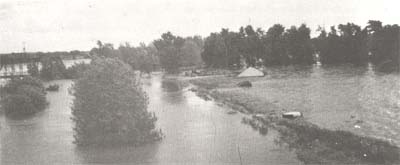
Meredosia Centennial Book
River Landforms, continued
Back Swamps and Backwater Lakes are formed in low areas of the floodplain when rivers flood over a natural levee. The spring floodwaters may become trapped behind the levee as the river falls. These lakes were isolated from the river channel during the rest of the year. Hundreds of backwater lakes originally dotted the Illinois River floodplain. They held standing water and had soft, muddy bottoms. They were filled with acquatic plants. The lakes were important spawning areas for fish and feeding areas for waterfowl.
Active Floodplain develops as the river channel moves back and forth in its valley, depositing sediment and increasing the valley's width. It is repeatedly covered with water whenever the river overflows its banks.
Terraces form when a river cuts down its channel, forming a new floodplain lower than the earlier one. Terraces are the higher-level surfaces of earlier floodplains.
A Meander is the winding motion that a river makes as it snakes back and forth through the floodplain. Rivers constantly shift their channel by cutting against the outside of the bends and dumping the residue on the inside bends. As a result, banks form on the outside of the meander while sand or gravel bars form on the inside.
Oxbow lakes and abandoned channels are the result of rivers sometimes change
courses. A river may cut off part of a channel at a place where the river
bends. If the abandoned channel still holds water, it is called an oxbow lake.